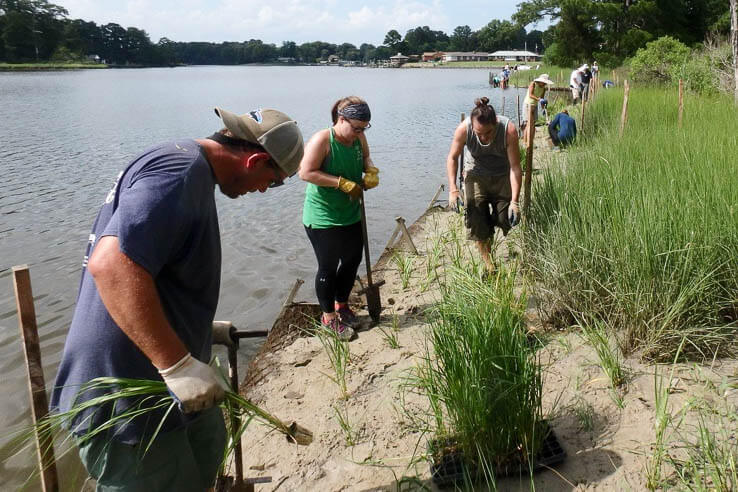A new shoreline uses oyster castles to shield a community
Volunteers in a Virginia neighborhood work together to restore their backyard

Wetlands are critical ecosystems in the Chesapeake Bay that absorb storm surges, filter pollutants and attract a wide diversity of species. Unfortunately, thousands of acres of wetlands throughout the Chesapeake region have been lost to development and sea level rise, so restoring wetlands is vitally important. Most wetland restoration projects in the watershed occur on agricultural land, but in smaller, coastal communities, the focus is on creating living shorelines.
A living shoreline is a coastal edge made of natural materials such as plants, sand or rock. These “soft” shorelines can grow over time, unlike a concrete seawall or other hard structure. Living shorelines filter pollutants to improve water quality, are resilient against storms and provide habitat for fish and wildlife.
In a small community in Chesapeake, Virginia, landowner Rogard Ross wanted to see his neighborhood thrive from these benefits. Ross lives on the Indian River, part of the Elizabeth River’s heavily polluted Eastern Branch. To improve the health of the Elizabeth River, the Elizabeth River Project (ERP) implements education and restoration projects, focusing largely on the Eastern Branch communities of Chesapeake, Norfolk, and Virginia Beach. When Ross learned that ERP was interested in doing a living shorelines project, he suggested his waterfront home and the neighboring homes in his condo association as a restoration site.
A hybrid approach
The shoreline restoration project had two key components: the planting of native marsh grasses and the installation of oyster castles. Oyster castles are interlocking blocks made from a blend of concrete and oyster shells. They serve as a surface for juvenile oysters, or spat, to grow on, which is crucial when there aren’t enough naturally occurring shells to start to a reef.
Oyster castles work well for shoreline restorations because they can be configured in multiple ways. Blocks can easily be added to extend the length of the shoreline and stacked to the perfect height to reduce wave energy and provide shoreline protection. One oyster can filter more than 50 gallons of water in a single day, so including oyster castles in the restoration provides clean water benefits. Behind the buffer of oyster castles, the native marsh plants provide additional erosion protection, filter pollutants from runoff and provide wildlife habitat.

A community effort
In June 2018, 200 volunteers helped complete the 550-foot living shoreline project. They installed 800 oyster castles and planted 5,000 native Spartina alterniflora and Spartina patens marsh plants. The project would not have been possible without ERP, who took care of permits, raised funding, brought in materials and recruited volunteers. While the condo association paid a small share of the total cost, most of the project was funded through the National Fish and Wildlife Foundation’s Chesapeake Bay Stewardship Fund. The Chesapeake Bay Stewardship Fund is funded through the U.S. Environmental Protection Agency. Other partners in the restoration included Friends of the Indian River, which was founded by Rogard, the Chesapeake Bay Foundation, whose oyster restoration program brought in 85 bushels of oyster shell, and a crew from the U.S. Navy to help lay the shell.
A variety of benefits
In the 10 years that Ross has lived on the river, he has noticed the water gradually getting clearer. Since the restoration project, he has noticed spat and barnacles on the oyster castles, as well as blue crabs and fish. As an avid birdwatcher and kayaker, Ross has observed about 70 different species of birds and mammals on his property, including pelicans, osprey, eagles, buffleheads, herons and gray foxes.
Ross feels that the community is now better prepared for the effects of weather and climate as well. “Besides providing more habitat and cleaning the water with the oysters, [the restoration] also provides erosion protection,” he said. The marsh provides a strong buffer against storms and sea level rise, helping to protect property from erosion and flooding.
Interested in learning about how to restore wetlands on your property? Please visit WetlandsWork.org.

Comments
While Gus Lorber of Allied Concrete and I originally designed oyster castles to provide vertical relief in restoring dead intertidal oyster reefs on the Seaside of the Eastern Shore, they have taken on a new role as sills for living shoreline restoration around the Chesapeake Bay.
Thank you!
Your comment has been received. Before it can be published, the comment will be reviewed by our team to ensure it adheres with our rules of engagement.
Back to recent stories